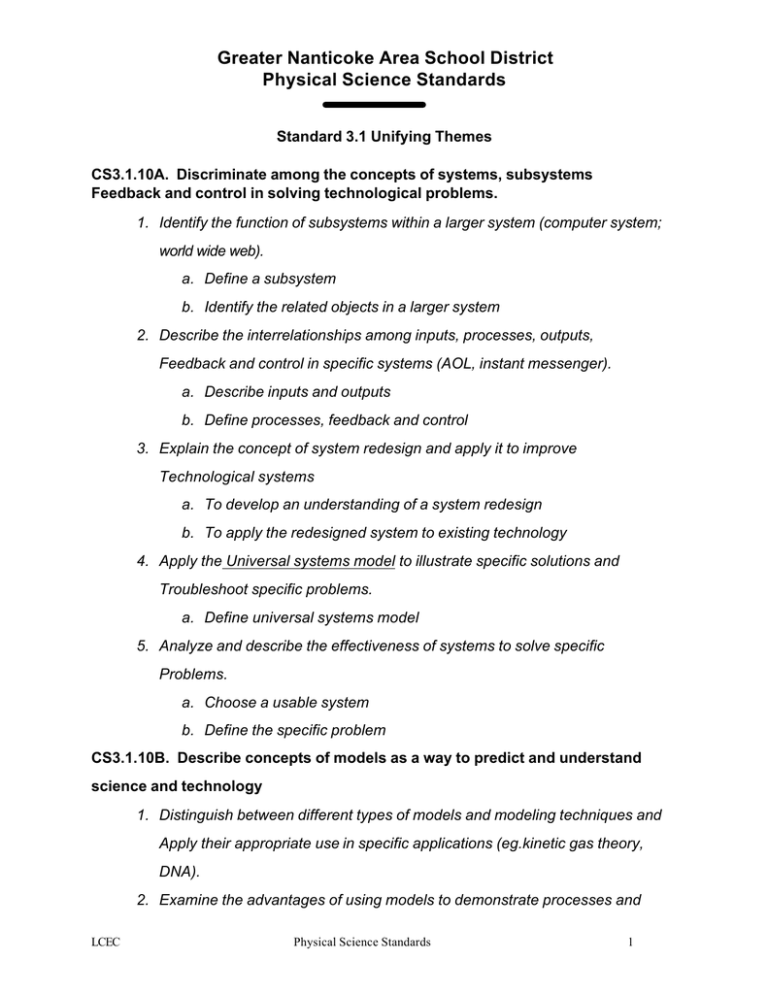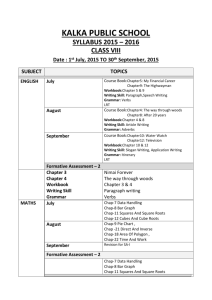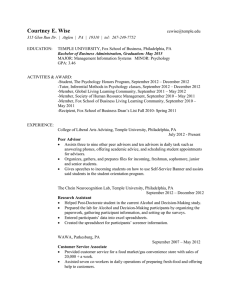Physical Science Standards - Greater Nanticoke Area School District
advertisement

Greater Nanticoke Area School District Physical Science Standards Standard 3.1 Unifying Themes CS3.1.10A. Discriminate among the concepts of systems, subsystems Feedback and control in solving technological problems. 1. Identify the function of subsystems within a larger system (computer system; world wide web). a. Define a subsystem b. Identify the related objects in a larger system 2. Describe the interrelationships among inputs, processes, outputs, Feedback and control in specific systems (AOL, instant messenger). a. Describe inputs and outputs b. Define processes, feedback and control 3. Explain the concept of system redesign and apply it to improve Technological systems a. To develop an understanding of a system redesign b. To apply the redesigned system to existing technology 4. Apply the Universal systems model to illustrate specific solutions and Troubleshoot specific problems. a. Define universal systems model 5. Analyze and describe the effectiveness of systems to solve specific Problems. a. Choose a usable system b. Define the specific problem CS3.1.10B. Describe concepts of models as a way to predict and understand science and technology 1. Distinguish between different types of models and modeling techniques and Apply their appropriate use in specific applications (eg.kinetic gas theory, DNA). 2. Examine the advantages of using models to demonstrate processes and LCEC Physical Science Standards 1 Outcomes (e.g. blue print analysis, structural stability). 3. Apply mathematical models to science and technology. a. Identify the available mathematical models used as tools. CS3.1.10C. Apply patterns as repeated processes or recurring elements in science and technology 1. Examine and describe recurring patterns that form the basis of biological classification, chemical periodicity, geological order and astronomical order. 2. Examine and describe stationary physical patterns 3. Examine and describe physical patterns in motion. CS3.1.10D. Apply scale as a way of relating concepts and ideas to one another by some measure. 1. Apply dimensional analysis and scale as a ratio 2. Convert one scale to another CS3.1.10E. Describe patterns of change in nature, physical and man made systems 1. Describe how fundamental science and technology concepts are used to solve practical problems (e.g., momentum, Newton’s laws of universal gravitation, tectonics, conservation of mass and energy, cell theory, theory of relativity, Pasteur’s Germ Theory, Galileo’s Heliocentric Solar System, gas laws, feedback systems). a. Define pertinent fundamental science and technology terms 2. Recognize that stable systems often involve underlying dynamic Changes (e.g., a chemical reaction of equilibrium has molecules Reforming continuously. a. Define a stable system 3. Describe the effects in measurements. 4. Describe changes to matter caused by heat, cold, light or chemicals Using a rate function a. Explain a rate function LCEC Physical Science Standards 2 Standard 3.2 Inquiry and Desgin CS3.2.10A. Apply knowledge and understanding about the nature of scientific and technological knowledge 1. Compare and contrast scientific theories and beliefs 2. Know that science is limited to the study of observable aspects of the World and the universe a. Teach importance of and difference between quantitative and Qualitative data 3. Integrate new information into existing theories and explain implied Results. CS3.2.10B. Apply process knowledge and organize scientific and technological phenomena 1. Describe materials using precise quantitative and qualitative skills Based on observations. a. Observe materials to determine physical (qualitative) and Measurable (quantitative) attributes. 2. Develop appropriate scientific experiments; raising questions, Formulation hypotheses, testing, controlled experiments, recognizing variables, manipulating variables, interpreting data and Producing solutions. a. Review appropriate process skills used in the scientific method. 4. Use process skills to make inferences and predictions using collected information and to communicate, using space/time relationships, defined operationally. CS3.2.10C. Apply the elements of scientific inquiry to solve problems 1. Generate questions about objects, organisms and/or events that can Be answered through scientific investigations. 2. Evaluate the appropriateness of questions. 3. Design an investigation with adequate control and limited variables to Investigate a question. 4. Conduct a multiple step experiment. LCEC Physical Science Standards 3 5. Organize experimental information using a variety of analytic methods. 6. Judge the significance of experimental information in answering the Question. 7. Suggest additional steps that might be done experimentally CS3.2.7D. Know and use the technological design process to solve problems 1. Define different types of problems. 2. Define all aspects of the problem, necessary information and questions That must be answered. a. Identify/analyze key components of the problem. b. List needed information c. Consider relevant background information 3. Propose the best solution. a. Discuss multiple solutions. CS3.2.10D. Identify and apply the technological design process to solve problems. 1. Examine the problem, rank all necessary information and all questions That must be answered. a. Decipher the parts of the problem. b. Examine provided research related to the problem c. Sort and rank all relevant information d. State all questions to be addressed 2. Propose and analyze a solution. a. List possible solutions b. Evaluate and select the most effective solution 3. Implement the solution a. A. Initiate investigations 4. Evaluate the solution, test, redesign and improve as necessary a. Create an alternative solution b. Implement changes 5. Communicate the process and evaluate and present the impacts of the Solution LCEC Physical Science Standards 4 a. Examine methods of reporting b. Utilize various means of communicating results c. Discuss and analyze effect of outcomes on other variables Standard 3.4 Physical Science, Chemistry and Physics CS3.4.10A. Explain concepts about the structure and properties of matter. 1. Know that atoms are composed if even smaller sub-atomic structures Whose properties are measurable. 2. Explain the repeating pattern of chemical properties by using the Patterns of atomic structure within the periodic table. 3. Predict the behavior of gases through the use of Boyle’s, Charles’ Or the ideal gas law, in everyday situations, 4. Describe phases of matter according to the Kinetic Molecular Theory. 5. Explain the formation of compounds and their resulting properties Using bonding theories (ionic and covalent) 6. Recognize formulas for simple inorganic compounds 7. Describe various types of chemical reactions by applying the laws Of conservation of mass and energy. 8. Apply knowledge of mixtures to appropriate separation techniques 9. Understand that carbon can form several types of compounds CS3.4.12A. Apply concepts about structure and properties of matter 1. Apply rules of systematic nomenclature and formula writing to chemical Substances CS3.4.10B. Analyze energy sources and transfers of heat 1. Determine the efficiency of chemical systems by applying mathematical formulas. 2. Use knowledge of chemical reactions to generate an electrical current 3. Evaluate energy changes in chemical reactions 4. Use knowledge of conservation of energy and momentum to explain Common phenomena (e.g., refrigeration system, rocket propulsion) LCEC Physical Science Standards 5 5. Explain resistance, current and electr-motive force (Ohm’s Law) CS3.4.10C. Distinguish among the principles of force and motion 1. Identify the relationship of electricity and magnetism as two aspects of A single electromagnetic force 2. Identify elements of simple machines in compound machines 3. Explain fluid power systems through the design and construction of Appropriate models 4. Describe sound effects (e.g., Doppler effect, reflection, refraction, Absorption, sonar, seismic) 5. Describe light effects (e.g., Doppler effect, dispersion, absorption, Emission spectra, polarization, interference) 6. Describe and measure the motion of sound, light and other objects 7. Know Newton’s Laws of Motion (including inertia, action and reaction) And gravity and apply them to solve problems related to forces and mass. 8. Determine the efficiency of mechanical systems by applying Mathematical formulas. Standard 3.7 Technological Devises CS3.7.10B. Apply appropriate instruments and apparatus to examine a variety of objects and processes 1. Describe and use appropriate instruments to gather and analyze data 2. Compare and contrast different scientific measurement systems; select the best measurement system for a specific situation. 3. Explain the need to estimate measurements within error of various instruments. a. Precision vs. accuracy 4. Apply accurate measurement knowledge to solve everyday problems 5. Describe and demonstrate the operation and use of advanced instrumentation in evaluating material and chemical properties (e.g., Scanning electron microscope, nuclear magnetic resonance machines) LCEC Physical Science Standards 6 CS3.7.12B. Evaluate appropriate instruments and apparatus to accurately measure materials and processes Standard 33.8 Science, Technology and Human Endeavors CS3.8.10A. Analyze the relationship between societal demands and scientific and technological enterprises 1. Identify past and current tradeoffs between increased production, Environmental harm and social values (e.g., increased energy needs, Power plants, automobiles). a. Energy use (fossil fuels, nuclear (etc.) b. Landfills/reduce, reuse and recycle c. Pollution-air, land, water d. Quality of Life 2. Compare technologies that are applied and accepted differently in Various cultures (e.g., factory farming, nuclear power) a. Farming methods b. Power Sources c. Transportation d. Medical treatments e. Personal enhancements-cosmetics, household appliances, (microwaves, etc.) 3. Describe and evaluate social change as a result of technological Developments. a. Mobility b. Opportunities (leisure, employment, residence (etc.) CS3.8.10B. Analyze how human ingenuity and technological resources satisfy specific human needs and improve the quality of life. 1. Identify several problems and opportunities that exist in your Community, apply various problem-solving methods to design and evaluate possible solutions. 2. Analyze a recently invented item, describing the human need that LCEC Physical Science Standards 7 Prompted its invention and the current and potential social impacts of the specific invention. CS3.8.12B. Apply the use of ingenuity and technological resources to solve specific societal needs and improve the quality of life 1. Apply appropriate tools, materials and processes to solve complex Problems. 2. Use knowledge of human abilities to design or modify technologies that Extend and enhance human abilities. 3. Apply appropriate tools, materials and processes to physical, Informational or biotechnological systems to identify and recommend Solutions to international problems CS3.8.10C. Evaluate possibilities consequences and impacts of scientific And technological solutions 1. Relate scientific and technological advancements in terms of cause And effect. a. Energy use b. Pollution c. Quality of Life d. Moral issues 2. Describe and evaluate the impacts that financial considerations have Had on specific scientific and technological applications Ecology Standards Standard 4.2. Renewable and Nonrenewable Resources CS4.2.10A. Explain that renewable and nonrenewable resources supply energy and materials. 1. Identify alternative sources of energy 2. Identify and compare fuels used in industrial and agricultural societies. 3. Compare and contrast the cycles of various natural resources a. Carbon cycle, Nitrogen cycle, Phosphorous cycle, Water cycle etc. LCEC Physical Science Standards 8 4. Explain food and fiber as renewable resources a. Composting Standard 4.3. Environmental Health CS4.3.10B. Explain how multiple variables determine the effects of pollution on environmental health, natural processes and human practices. 1. Explain how human practices affect the quality of the water and soil 2. Identify evidence of natural events around the world and their effects on environmental health (e.g., Yellowstone National Park fires). 3. Identify local and state environmental regulations and their impact on environmental health. 4. Analyze data and explain how point source pollution can be detected and eliminated. a. Describe the processes involved in measuring point source pollution 5. Identify and explain ways of detecting pollution by using state-of-theArt technologies. LCEC Physical Science Standards 9


